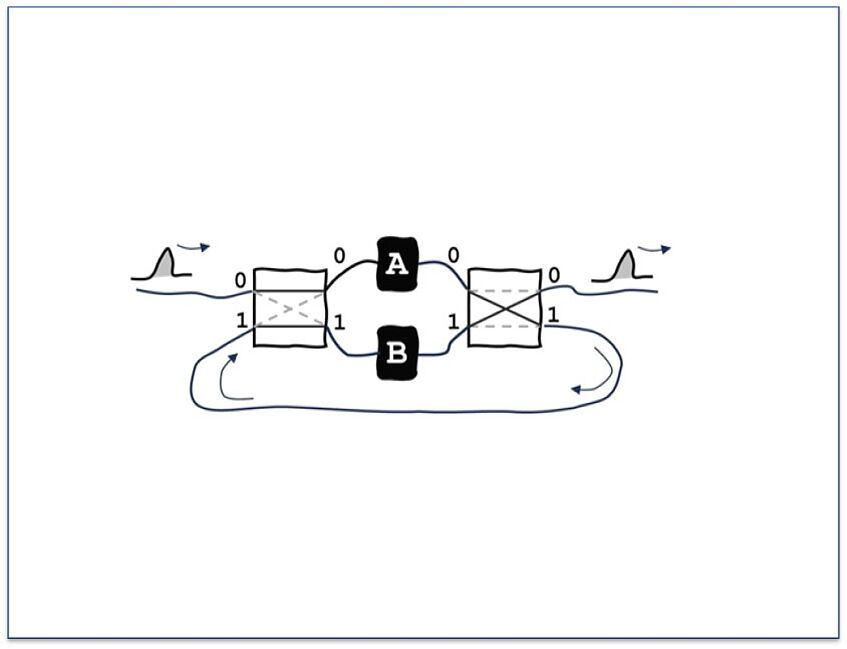Quantum Causality and Temporal Relations in Quantum Theory

Quantum Switch
(c) Jonas Schmöle/Lee Rozema

experimental set-up for a quantum switch
(c) Jonas Schmöle/Lee Rozema
Quantum Causality and Temporal Relations in Quantum Theory
In our everyday life, we experience events in a well-defined order. This means that event A can only occur before, after or at the same time as a second event B. It turns out that this intuition carries over through most of our scientific theories. Even in quantum theory, where we often talk about a particle being in two places at once, scientists tend to make implicit assumptions about the order of events. A good example of this is quantum computation. In a quantum computer we imagine applying quantum gates to some quantum bit. While that quantum bit can be in a superposition of different states, the order in which the gates are applied is always fixed. It wasn’t until 10-15 years ago that it was appreciated that we could also superpose the order in which gates are applied. In other words, we can take two gates and apply them to a quantum bit in two orders at the same time.
It turns out that this can have drastic consequences for quantum information processing. Some tasks can be done more efficiently than when the gates are applied in a fixed order, and it is also possible to do some things that cannot be done with a “normal” quantum computer. In this project, we are interested in developing techniques to create superpositions of orders, characterize these superpositions, and then exploit them by trying to outperform standard quantum approaches.
Publications (selected)
Experimental Aspects of Indefinite Causal Order in Quantum Mechanics
L.A. Rozema, T. Strömberg, H. Cao, Y. Guo, B. Liu, P. Walther
arXiv:2405.00767 (2024).
Higher-order Process Matrix Tomography of a passively-stable Quantum SWITCH
M. Antesberger, M. Tulio Quintino, P. Walther, L.A. Rozema
PRX Quantum 5, 010325 (2024).
Experimental superposition of time directions
T. Strömberg, P. Schiansky, M. Tulio Quintino, M. Antesberger, L.A. Rozema, I. Agresti, C. Brukner, P. Walther
Physical Review Research 6, 023071 (2024).
Demonstration of universal time-reversal for qubit processes
P. Schiansky, T. Strömberg, B. Trillo, V. Saggio, B. Dive, M. Navascués, P. Walther
Optica 10, 200 (2023).
Experimental semi-device-independent certification of indefinite causal order in a photonic quantum switch
H. Cao, J. Bavaresco, N. Wang, L.A. Rozema, C. Zhang, Y. Huang, B. Liu, C. Li, G. Guo, P. Walther
Optica 10, 561-568 (2023).
Demonstration of a Quantum Switch in a Sagnac Configuration
T. Strömberg, P. Schiansky, R. W. Peterson, M. T. Quintino, P. Walther
Physical Review Letters 131, 060803 (2023).
Experimental Entanglement of Temporal Orders
G. Rubino, L. A. Rozema, F. Massa, M. Araújo, M. Zych, C. Brukner, P. Walther
Quantum 6, 621, (2022).
Experimental Quantum Communication Enhancement by Superposing Trajectories
G. Rubino, L. A. Rozema, D. Ebler, H. Kristjánsson, S. Salek, P. Allard Guérin, A.A. Abbott, C. Branciard, Č. Brukner, G. Chiribella, P. Walther,
Physical Review Research 3, 013093 (2021).
Experimental Verification of an Indefinite Causal Order
G. Rubino, Lee A. Rozema, A. Feix, M. Araújo, L.M. Procopio, C. Brukner, P. Walther
Science Advances 3, e1602589 (2017).
Experimental Superposition of Orders of Quantum Gates
L.M. Procopio, A. Moqanaki, M. Araújo, F. Costa, I.A. Calafell, E.G. Dowd, D.R. Hamel, L.A. Rozema, C. Brukner, P. Walther,
Nature Communications 6, 7913 (2015).
